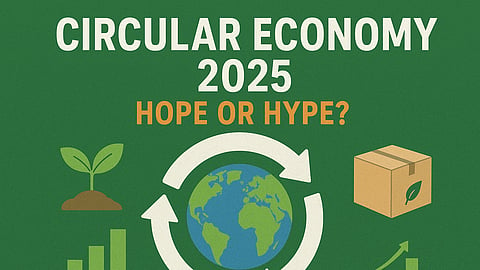Circular Economy at the Crossroads: Can the World Truly Live Without Waste?
In a time when the planet faces severe resource depletion, pollution, and climate breakdown, the circular economy offers a revolutionary alternative to the linear “take-make-dispose” system. Instead of discarding products after use, it aims to keep materials circulating—through reuse, repair, remanufacturing, and recycling—while regenerating natural systems.
According to the Ellen MacArthur Foundation, the model stands on three pillars:
Eliminate waste and pollution by design
Circulate products and materials at their highest value
Regenerate natural systems
This shift promises both ecological balance and economic opportunity. From smartphones designed for easy disassembly to fashion lines using recycled fibers, industries are rethinking production to extend material life.
But the key question remains: is the world truly ready to live without waste—or are we just repackaging sustainability as a trend?
2025: The Year Circularity Went Mainstream
Once a niche idea, the circular economy has now entered the mainstream—driven by policy mandates, investor priorities, and consumer awareness.
The EU’s Circular Economy Action Plan enforces eco-design and extended producer responsibility.
The global market is estimated to grow from $463 billion (2024) to $798 billion (2029)—a CAGR of 11.4%.
Digital circularity—including blockchain-based product tracking—is projected to quadruple by 2032.
Circularity is also transforming specific sectors:
Built environment: could cut emissions by up to 75% by 2050.
Developing nations: repair and refurbish-based industries are creating green jobs without resource overexploitation.
Cryptocurrency ecosystems: places like El Salvador’s Berlín have adopted Bitcoin-based circular models for local economies.
Despite the progress, challenges remain. A BSI 2025 report shows that 57% of consumers still don’t fully understand what circularity means—revealing a serious trust and knowledge gap.
While the potential is enormous, only 6.9% of materials currently re-enter the loop. The rest—over 90%—still come from virgin extraction. High-income nations consume six times more resources per capita than low-income ones, exposing the circular economy’s equity deficit.
Leading the Way: Who’s Doing It Right?
Patagonia: Worn Wear program repairs and resells old clothing—saving resources while enhancing brand loyalty.
IKEA: Targets 100% circular operations by 2030, using recycled materials and buy-back schemes.
Unilever: Aims to cut packaging waste by 25% by 2025.
Philips: 25% of revenue from circular models by 2025 through product leasing.
The Netherlands: En route to a fully circular economy by 2050 through strict policy frameworks.
These examples prove that profit and purpose can align—but only when circularity is built into the business DNA, not added as a marketing accessory.
The Harsh Reality: Barriers That Persist
Despite corporate success stories, major roadblocks are holding back a true transformation:
Consumer Distrust:
56% doubt circular product quality
51% question safety
32% suspect greenwashing
Economic and Structural Gaps:
Global recycling infrastructure remains inadequate.
57% of waste ends up in uncontrolled landfills.
$1.4 trillion in fossil fuel subsidies still favor the linear model.
Cultural Obstacles:
Wealthier societies remain addicted to novelty and consumption. Without enforced caps on material extraction, “circularity” risks becoming an elite sustainability badge, while poorer nations become the waste processors of the world.
Expert Insights: Innovation vs. Inequality
“Through design, we can eliminate waste, circulate products, and regenerate nature,” says the World Economic Forum.
Experts emphasize that incentives will drive adoption faster than ideals. Token-based reward systems, as seen in crypto-circular economies, could encourage participation—but without social safeguards, they risk widening inequalities.
Circularity, therefore, needs more than technological fixes. It needs redistributive policies, global governance, and consumer education to avoid becoming just another greenwashing trend.
Looking Ahead: The Road to 2050
If left unchecked, material use will hit 160 billion tonnes by 2060. However, with aggressive circular strategies:
Virgin material use could drop to 8 tonnes per capita.
Global throughput could fall to 83.9 billion tonnes by 2032.
Experts recommend:
Creation of an International Materials Agency to govern global extraction.
Adoption of ISO 59000 standards for verifying circular claims.
Subsidy reforms shifting funds from fossil fuels to green infrastructure.
Final Word: The Circular Choice
The circular economy has evolved from theory to mainstream movement. It holds the promise of a regenerative, resilient world—but also exposes the gap between aspiration and action.
If governments enforce real accountability, businesses move beyond PR, and consumers embrace reuse over convenience, the vision of a waste-free planet is still within reach.
If not, “circularity” risks becoming the next sustainability illusion—a closed loop that never really closes.


